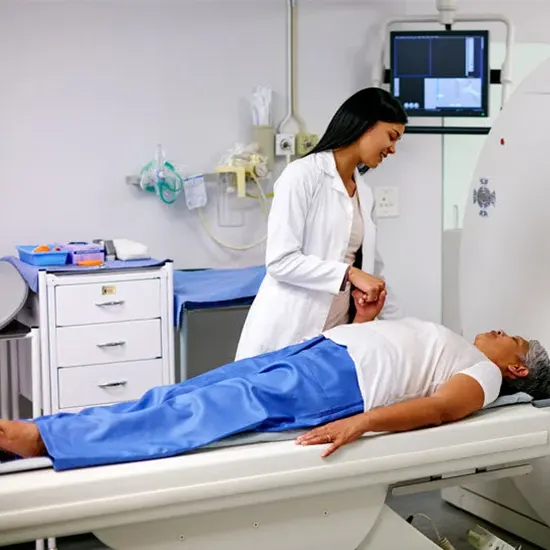
A magnetic resonance imaging (MRI) scan is a non-invasive imaging technique that uses powerful magnets and radio waves to generate detailed images of the body. MRI scans are often used to examine the head and neck area to...
A magnetic resonance imaging (MRI) scan is a non-invasive imaging technique that uses powerful magnets and radio waves to generate detailed images of the body. MRI scans are often used to examine the head and neck area to diagnose a range of conditions, such as tumors, infections, and injuries.
If you are scheduled for a head and neck MRI scan, it is natural to feel anxious or worried about the procedure. However, understanding what to expect during the scan can help ease your concerns. In this blog, we will discuss the procedure for a head and neck MRI scan in detail.
Preparation for the Scan
There are specific instructions that you will need to follow before undergoing an MRI scan. This will mostly include staying empty stomach or avoiding drinking anything. This will be informed to you by your healthcare provider. This is because food and drink can affect the image quality, and a full stomach can make you feel uncomfortable during the scan.
You will also need to remove any metallic objects from your body, such as jewelry, watches, and hairpins. Metallic objects can interfere with the magnetic field and affect the image quality. If you have a pacemaker or other implanted medical devices, you should inform your healthcare provider beforehand.
If you feel anxious or claustrophobic, you can ask for a mild sedative to help you relax during the scan. However, you will need someone to drive you home afterward as sedatives can impair your ability to drive.
The MRI Scan Procedure
On the day of the scan, you will be asked to change into a hospital gown and lie down on a narrow table that slides into the MRI machine. The machine is a large, tube-like structure with a magnetic field that is several times stronger than the Earth's magnetic field.
During the scan, you will need to lie still as any movement can blur the images. The machine will make loud thumping and tapping noises, so you will be given earplugs or headphones to wear. You can also listen to music or an audiobook to help pass the time.
In some cases, you may need to receive a contrast agent, a special dye that helps to enhance the image quality. The contrast agent is usually injected into a vein in your arm. You may feel a brief sensation of warmth or a metallic taste in your mouth, but this is normal and will pass quickly.
The scan can take anywhere from 30 minutes to an hour, depending on the type of images needed. If you are having multiple scans, you may need to reposition yourself between scans.
What Happens After the Scan?
Once the scan is complete, you can change back into your clothes and resume your normal activities. There are no restrictions on diet or activity after the scan, and you can usually drive home or return to work immediately.
The images from the scan will be sent to a radiologist, a specialist who interprets medical images. The radiologist will analyze the images and send a report to your healthcare provider. Your healthcare provider will then discuss the results with you and determine the best course of action.
Risks and Benefits
MRI scans are generally safe and non-invasive and diagnostic centres like Ganesh Diagnostic Centres provide good discounts on the cost of head and neck MRI scan. Unlike X-rays and Ultrasound, CT scans, MRI scans do not use ionizing radiation, which can be harmful in large doses. However, there are some risks associated with the scan.
One risk is the possibility of an allergic reaction to the contrast agent. Although rare, some people may experience an allergic reaction, which can range from mild itching and hives to a more severe reaction such as anaphylaxis.
Another risk is the possibility of claustrophobia. The MRI machine is a small, enclosed space, and some people may feel anxious or uncomfortable during the scan. If you have a history of claustrophobia, you can talk to your healthcare provider about taking a mild sedative or using an open MRI machine.
Despite the risks, there are several benefits of having a head and neck MRI scan. The scan can help diagnose a range of conditions, such as tumors, infections, and injuries, that may not be visible on other imaging tests such as X-rays or CT scans. Early diagnosis can lead to earlier treatment, which can improve outcomes and reduce the risk of complications.
Conclusion
A head and neck MRI scan is a non-invasive imaging test that uses powerful magnets and radio waves to produce detailed images of the body. The procedure is safe and generally well-tolerated, although some people may experience anxiety or discomfort during the scan.
If you are scheduled for a head and neck MRI scan, it is important to follow the preparation instructions given by your healthcare provider and inform them of any medical conditions or implanted devices colour doppler you have. By cardiology understanding what to expect during the scan, you can feel more confident and relaxed about the procedure.
If you have any concerns or questions about the scan, you can talk to your healthcare provider. You can call Ganesh Diagnostic Centre anytime in case you want to know head MRI price. They can provide you with more information about the procedure, including the risks and benefits, and help you make an informed decision about whether the scan is right for you.









